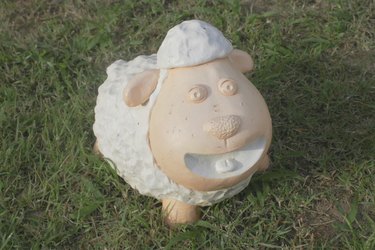
A low-temperature clay that you cure in the oven, polymer clay offers a myriad of possibilities if you have a creative itch that needs scratching. The clays come in multiple colors, but you can also paint them with special polymer paints or use acrylic paints. Don't apply acetone or solvents, nail polish, spray or enamel paints to your finished product, as these degrade and soften the clay, even after it's cured.
A Bit of History
Video of the Day
A doll-maker invented the first polymer clays in 1930s Germany when she ran out of materials to sculpt the heads for her dolls. In 1964, she sold the formula to a man who started a polymer clay manufacturing company after modifying the formula. He sold his clay under a well-known brand name in Europe, where, since you don't need a kiln to harden the clay, it rapidly caught on as an arts-and-crafts medium. An American company developed a formula for the clay for an industrial application that didn't work, but in the process, the company discovered the clay worked well for craft projects. Polymer clays consist of poly-vinyl chloride materials, solvents and pigments that harden when baked at temperatures that range from 215 to 325 degrees Fahrenheit.
Video of the Day
Working the Clay
After you take polymer clay from its package, knead it thoroughly to soften it and make it malleable. You can use household tools -- knives, rolling pin, graters and even a pasta machine -- to work with the clay, as long as you dedicate them to clay use only. Work the clay on a smooth surface like a glazed ceramic tile, clear acrylic sheet or a sheet of glass. When you don't plan to use a portion of the clay after removing it from the package and working it, store it in sandwich or plastic bags that seal tightly; label the package with the color name and clay brand.
Polymer Projects
Crafters make jewelry beads, earrings, necklaces, brooches and pins out of the clay, but you can sculpt doll heads or figurines, busts, garden markers or wall masks from the clay as well. Project ideas for polymer clay abound, many of which you can find online. When making larger standing figurines, build an armature first -- a skeleton out of aluminum or brass wire -- to hold the clay in the desired shape.
Curing Polymer Clay
Add an oven thermometer -- the type that hangs from the rack -- to the oven to verify accurate temperatures. Polymer clay baking times vary by brand, but they are determined by the thickness of the clay, as noted on the clay's packaging materials. Depending on the brand bake the clay 10 to 30 minutes, for each 1/4 inch of clay thickness. Preheat the oven and place your polymer clay atop a glazed ceramic tile during baking. After removing the project from the oven, let it cool until it hardens, as it is slightly soft when you first take it out.